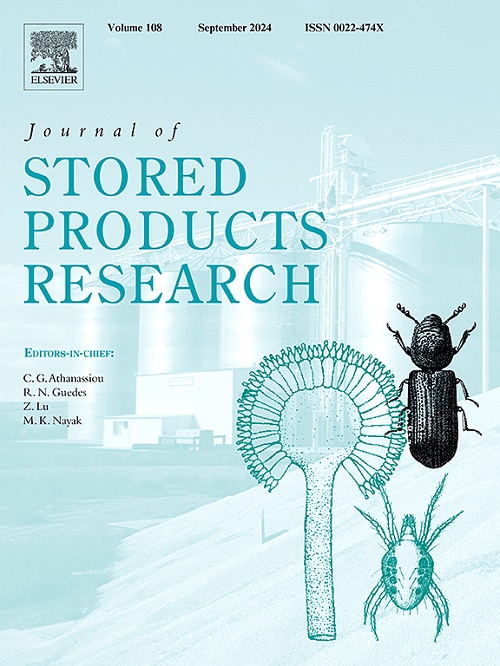Management strategy evaluation of stored grain using global sensitivity analysis: Part II – allowable maximum variations of temperatures and moisture contents of hemp seeds and durum wheat
IF 2.7
2区 农林科学
Q1 ENTOMOLOGY
引用次数: 0
Abstract
To avoid spoilage of stored grain, the allowable maximum variations of temperatures and moisture contents of different grain types should be characterized. Using the global sensitivity analysis method and procedure which were described in Part I, this study answered the following questions: what is the allowed maximum variation of grain moisture content when the average moisture content is at the recommended safe storage moisture content? What is the allowed maximum temperature variation? Whether should a large variation of initial germination be considered during the development of storage plan? Mathematical models published in literature for predicting germination reduction of hemp seeds and durum wheat were coded in Symbiology and Simulink for conducting more than 4000 simulations. Random and normal distributions of temperatures, moisture contents, and initial germinations were simulated. The simulated temperatures, moisture contents, and initial germinations were the same as that presented in Part I. The simulations concluded that hemp seeds were more sensitive to temperature than durum wheat and storing hemp seeds at ≥ 23 or storing wheat at ≥ 28 was a risk regardless of the moisture content. The storage risk level from high to low at the same condition was hemp seeds, canola, and durum wheat. The allowable maximum standard error of moisture content for one third of the safe storage time was 0.1 and 0.5 percentage point at any temperature for hemp seeds and durum wheat, respectively. Interaction effects between temperature and moisture content were more significant along with the increase of storage time.

使用全局敏感性分析的储存谷物的管理策略评价:第2部分-麻籽和硬粒小麦的温度和水分含量的允许最大变化
为避免贮藏粮食的变质,应确定不同粮食类型的温度和水分含量的允许最大变化。本研究采用第一部分中描述的全局敏感性分析方法和程序,回答了以下问题:当平均含水率达到建议安全储存含水率时,允许的最大含水率变化是多少?允许的最大温度变化是多少?在制定贮藏计划时,是否应考虑初始萌发的较大变化?在Symbiology和Simulink中编写了用于预测大麻种子和硬粒小麦发芽率降低的数学模型,进行了4000多次模拟。模拟温度、水分含量和初始发芽的随机分布和正态分布。模拟的温度、含水量和初始发芽与第一部分相同。模拟的结论是,大麻种子比硬粒小麦对温度更敏感,无论含水量如何,大麻种子在≥23°C或≥28°C的储存都是有风险的。相同条件下贮藏风险等级由高到低依次为麻籽、油菜籽、硬粒小麦。在任何温度下,大麻种子和硬粒小麦在三分之一安全贮存时间内的水分含量允许的最大标准误差分别为0.1和0.5个百分点。随着贮藏时间的延长,温度与水分的交互作用更为显著。
本文章由计算机程序翻译,如有差异,请以英文原文为准。
求助全文
约1分钟内获得全文
求助全文
来源期刊
CiteScore
5.70
自引率
18.50%
发文量
112
审稿时长
45 days
期刊介绍:
The Journal of Stored Products Research provides an international medium for the publication of both reviews and original results from laboratory and field studies on the preservation and safety of stored products, notably food stocks, covering storage-related problems from the producer through the supply chain to the consumer. Stored products are characterised by having relatively low moisture content and include raw and semi-processed foods, animal feedstuffs, and a range of other durable items, including materials such as clothing or museum artefacts.

 求助内容:
求助内容: 应助结果提醒方式:
应助结果提醒方式:


